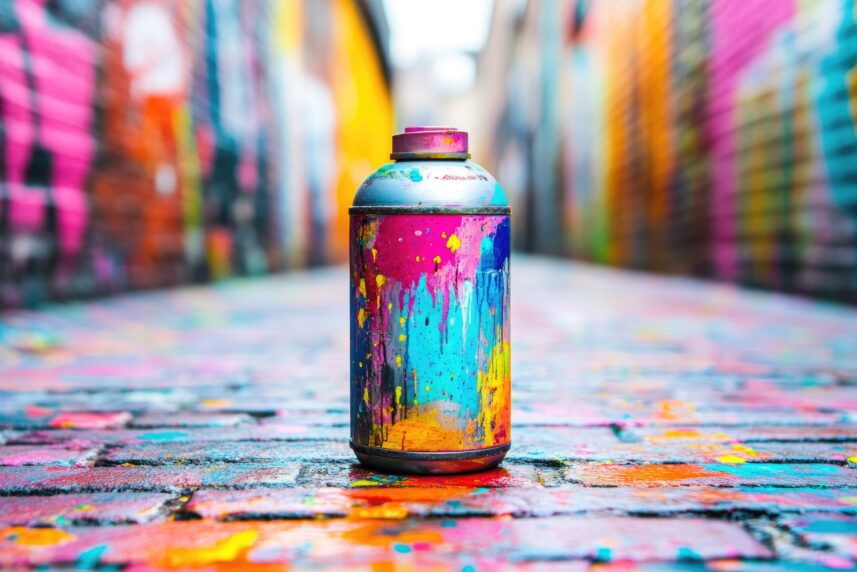Article:
PAINTING THE TOWN: APEX
TEXT AND PHOTOS BY DOLLY R. SICKLES
For the last 10 years, the Town of Apex has focused on developing its Public Art Master Plan. The Apex Public Art Committee (APAC) evolved from this initiative, which, according to chairperson Tom Colwell, “generates ideas, develops the concepts and determines the projects that we would like to advance.”
Murals and public art provide more than just a beautification of space—they build community. In North Carolina’s fastest-growing town, public art can be enjoyed through a myriad of murals, an art walk, a sculpture walk and along the GoApex bus route.
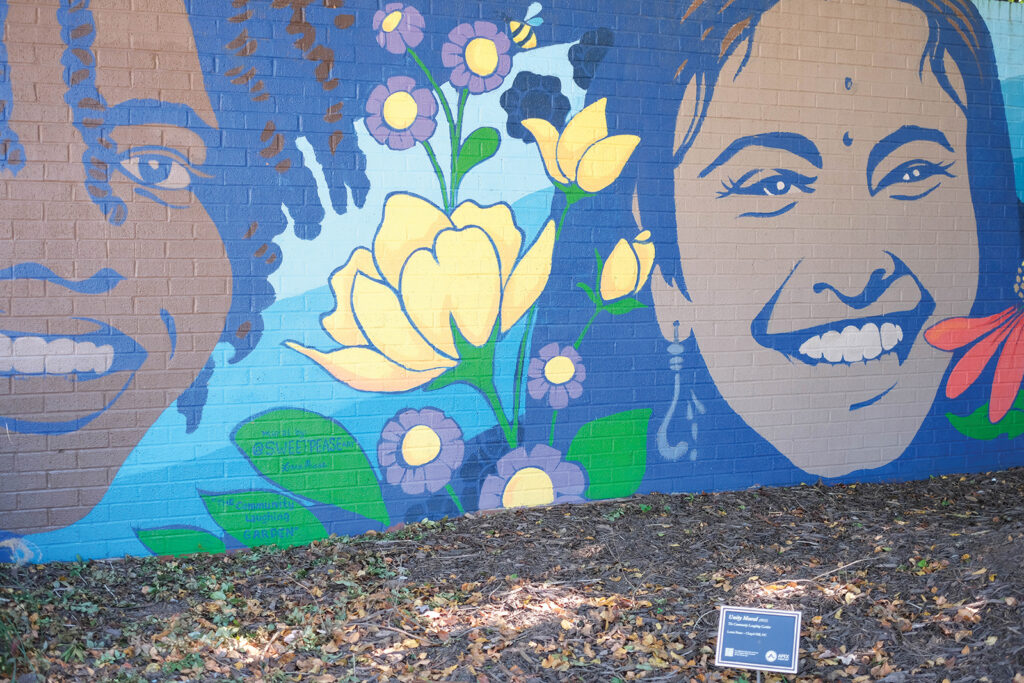
The Community Laughing Garden
Painted by Loren Pease in 2022.
Located at the downtown Apex police station, 205 Saunders Street.
“Murals create character,” says Chapel Hill muralist Loren Pease with Sweet Pease Art. “Using the side of a building to create a feeling is like creating a billboard for your community. It can be a pretty powerful thing.”
Pease’s style is colorful, joyful and natural; she is inspired by the colors, shapes and magic of living things around her. She says she just kind of fell into painting murals. “A friend in advertising asked if I could paint her nursery, and the next thing I knew I was painting every weekend in [different homes] and eventually businesses.” Pease says her goal “is to create something that invites the viewer to pause, think, reflect and connect with the yumminess of nature and life.”
Her mural, The Community Laughing Garden, highlights the joy she finds in people and the pure happiness and unity they can share. It was selected from one of APAC’s calls for art and completed in November 2022. “The committee felt strongly about this being a unity mural that somehow represented the people in the community,” she says. “Apex has a beautifully diverse population, and my goal was that anyone walking by could relate to someone in the mural in some small way.”

TapStation
Painted by Max Dowdle in 2022.
Located at TapStation, 320 S. Salem Street.
Max Dowdle has two murals in town that are part of his “Legacy NC–100 Murals in 100 Counties” project. He painted Destination Becomes Home in 2020 on the Apex Public Works building. It caught the attention of Jeff Kromenhoek, who owns TapStation.
“Jeff contacted me and said, ‘Hey, we’re renovating this building and turning it into TapStation, so just go wild on it,’” says Dowdle. The commissioned mural, TapStation, pays homage to the former Holt & Sons garage, on the corner of South Salem and Williams streets. It features beer and hops, and a fun robot gas attendant. Dowdle also painted the vintage truck out front.
Dowdle studied sculpture in college and discovered painting during his last term. After college, he studied in Florence, Italy for two years, learning the classical Old Master style with oil paints. Dowdle favors big, bold colors and silhouettes. He worked in other genres—fine arts, portraiture and graphic novels—before settling on murals and opening his company, NC Public Art. Working on murals lets him be outside, which he especially enjoyed during the pandemic. “I had such a great experience, working in tandem in a collaborative fashion with people who wanted to see a creative vision come to life,” he says.
Both Pease and Dowdle also have murals along the GoApex bus route. To learn more about Pease, check out sweetpease.com. To learn more about Dowdle, check out ncpublicart.com. All of Apex’s public art is documented at apexnc.org/1800/public-art.
PAINTING THE TOWN: CARY
TEXT AND PHOTOS BY ELIZABETH BRIGNAC
Public art is a hallmark of the Cary experience today. Nestled in parks and public spaces throughout the city, sculptures, paintings and other public artwork emerge to give the town beauty and character.
One of Cary’s oldest murals provokes curiosity, as it incorporates many of Cary’s historic figures and buildings—some of which no longer exist. Its newest mural is very different, with a focus on nature rather than culture. We spoke with the muralists who painted these two works to learn more about how the murals were composed and what ideas inspired them.
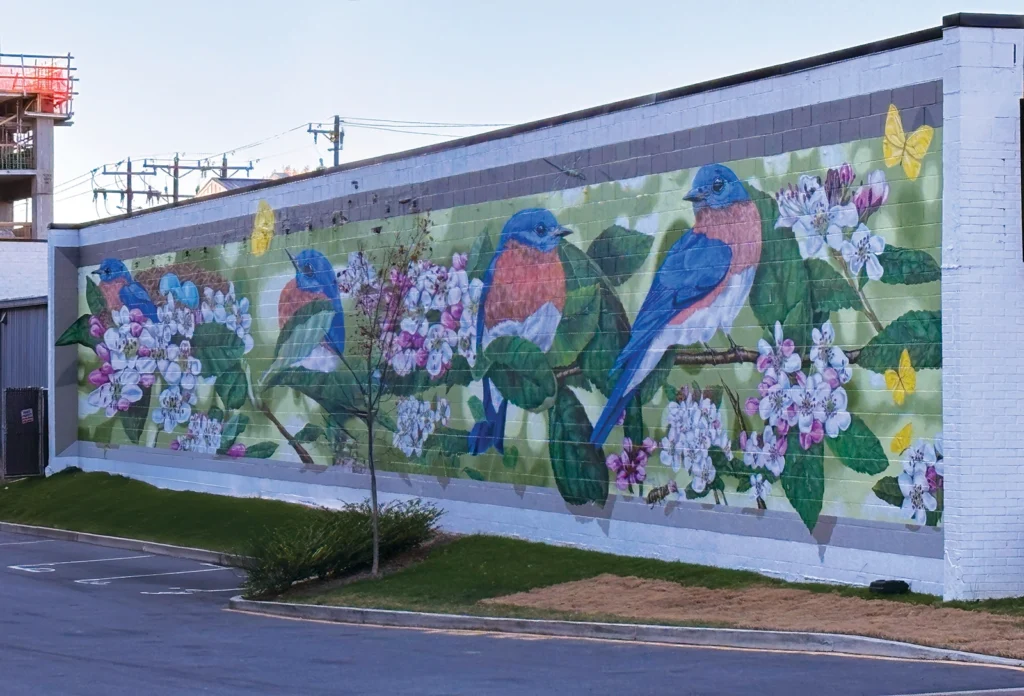
Blossoms and Birdsongs
Painted by Lisa Gaither, 2024.
Located at 160 E. Cedar Street, owned by Scratch Kitchen & Taproom.
Cary’s newest mural was painted in 2024 by muralist Lisa Gaither and adorns the wall of Scratch Kitchen & Taproom near Chatham Street in downtown Cary. It depicts four bluebirds surrounded by pink chokeberry blossoms. The mural is meant to be viewed from down Chatham Street, which is how most people see it. Viewed from directly in front of the mural, Gaither says, “The birds in the back are skewed; they’re stretched way out…their perspective is wrong. And that’s just so when you’re way down the street and you see them, they look normal.”
The depiction of bluebirds and chokeberries was chosen simply because both Scratch’s owners and Gaither liked how they looked. “It was kind of simple,” says Gaither. “[Chokeberries] are something we actually have in the area.” Gaither wanted a local bird and plant combination with colors that resonated with her—and she wanted it to be unpredictable. In this area, “everybody expects people to paint cardinals and dogwoods,” she says. “I said, ‘I’m not doing those because, you know, that’s what everybody expects.’”

Cary—Then and Now
Painted by Val Fox, 2002–2003.
Located at 220 W. Chatham Street, now owned by La Farm Bakery.
Born in 1938, Val Fox grew up in Cary and remembers it as a small town. “If anybody did anything, everybody in the town knew about it,” she says.
Fox painted Cary—Then and Now on the wall of what was then Sorrell Paint Wallpaper Interiors & Floors, where her studio was housed, at the suggestion of prominent community members Dick Ladd and Ralph Ashworth. She wanted to give an overview of Cary’s history over the 150 years that preceded the mural.
“I think it took me 8 months to do it—I could only paint in good weather,” she says. “Anyway, we got it done, and hallelujah!”
The images show moments in the history of Cary over time, starting at the right with the Cary train station, representing the town’s roots in the railroad, and moving roughly through time to the left. Images of people include Cary figures who were prominent in their time, some of whom were known to either Fox herself or her parents.
Dr. James Templeton, for example, a beloved local doctor who died only a few years before Fox was born, stands in his World War I uniform in front of the Cary train station. The man pumping gas is Jerrell Spencer, who owned Cricket Service Station (now called Cricket Service Center) and who was known to everyone in town, including Fox.
Some of the images are both personal and community-oriented; the teacher standing at the blackboard at the center of the mural, for example, is Ruth Cathey Fox, who taught for many years at Cary Elementary School before becoming principal of Briarcliff Elementary School. She was Fox’s stepmother. The man with the microphone to the far left is musician Clay Aiken, whose star was rising when Fox painted the mural—and whose mother worked in the Sorrell building near Fox’s studio.
The buildings depicted in the mural include well-known places, like the Pink House and the building at the end of Academy Street that was once Cary High School and is now the Cary Arts Center. They also include buildings that were once important but have since been torn down, like the barn from Kildaire Farm, the dairy farm that once stood on the road that currently bears its name.
Fox is in her 80s now, and the mural depicting Cary’s history is fading slowly from the wall of 220 West Chatham. “I just want everyone that lives in Cary to love each other, to respect each other, and to build each other up—be a big, happy family like we were, you know, 50 years ago, 80 years ago,” she says. “Just love Cary like us old folks used to love it.”
You can learn more about Cary—Then and Now at the Page-Walker Arts & History Center. They sell an inexpensive copy of the mural that includes a detailed account of its history.
PAINTING THE TOWN: FUQUAY-VARINA
BY HEATHER DARNELL | PHOTOS COURTESY OF THE TOWN OF FUQUAY-VARINA
Public art in Fuquay-Varina promotes community spirit and civic pride, and adds beauty to the town. Our local murals in particular draw attention to the town’s unique history within North Carolina.
The colorful I Love Fuquay-Varina mural in downtown Varina and the friendly Welcome Home mural in downtown Fuquay feature elements that showcase Fuquay-Varina as a unique and special place to live.

I Love Fuquay-Varina
Painted by Sean Kernick in 2018.
Located at 409 Broad Street, the current location of SupaBowlz Café.
The iconic I Love Fuquay-Varina mural is located on 409 Broad Street in downtown Varina. Visitors might stumble upon this work of art while shopping at Varina Station or when going to an Aviator restaurant or brewery. This mural was painted on the side of the brick building where SupaBowlz Café is currently located by prolific North Carolina artist Sean Kernick. Kernick has brought large-scale works of art to life across the state.
This visual love letter to the town writes the story of Fuquay-Varina. In the mural, American and North Carolina flags wave over local historic landmarks like Fuquay Mineral Spring Park. The mural uses bright colors and urban illustration that connect present elements of Fuquay-Varina to its past and future.
The I Love Fuquay-Varina mural was made possible by United Arts Wake County (UAWC) through the Wake Murals program in 2018. Kelly Schrader, United Arts coordinator at UAWC, says, “We work with municipalities across Wake County to guide them through the process of how to commission and install public murals. UAWC also contributes up to $5,000 of matching funds toward each mural and assists with all stages of the process.”
Maureen Daly, cultural director at the Fuquay-Varina Arts Center, remembers all the elements coming together quickly for this mural. “The I Love Fuquay-Varina mural came to us by chance,” she says. “I received a call from the United Arts Council president asking if we were in a position to have a mural in town, and if we could participate in their program quickly.” The Fuquay-Varina Arts Center, the Town of Fuquay-Varina and artist Sean Kernick all jumped on the opportunity to make it happen, working together to find a location and create and approve the concept.
“The mural is a great welcome to our Varina district, and is amongst the most photographed murals in town,” Daley says.

Welcome Home
Painted by Jermaine Powell in 2023.
Located at 201 S. Main Street, owned by Abshure Realty.
Fuquay-Varina’s Welcome Home mural is the town’s newest addition to downtown Fuquay. Completed in 2023, the mural is located at 215 S. Main Street on the south side of the Abshure Realty building and brings cheer to the town’s Vance Street parking lot. The mural is easily viewable to visitors traveling north on Main Street or when walking around downtown Fuquay.
The colorful mural represents a sense of home, with the American flag waving over the North Carolina state bird (the cardinal), the state flower (the flowering dogwood), and beautiful blue North Carolina skies.
Daly says that she planned the Welcome Home mural in collaboration with Dawn Russell, a former town manager, and the Abshure family, who own the Abshure Realty building. In the design process, the “welcome home” sentiment was a favorite.
The group identified Fuquay-Varina artist Jermaine Powell to bring the concept to life, and secured a placemaking grant from the National Association of Realtors through the Raleigh Regional Association of Realtors. Powell has installed murals across the state, and he also works in mediums like canvas, portraits and custom-painted handbags. In an April 21, 2023 Instagram post, Powell described his thoughts about the Welcome Home mural.
“As an artist, it’s always a joy to create something that celebrates the beauty and diversity of a community,” he writes. “I wanted my mural to highlight the many people who live and work in Fuquay-Varina, and to convey the warmth and welcoming spirit of this great town. With your help, I believe we achieved that goal.”
Daly notes that in the short time it has been viewable, the Welcome Home mural has been used in multiple town publications and has become a local landmark.
PAINTING THE TOWN: HOLLY SPRINGS
TEXT AND PHOTOS BY JENNIFER AXNESS
Murals have become a powerful way for towns across North Carolina to celebrate local culture, boost tourism and support small businesses. From urban neighborhoods to small towns, the growing mural movement in North Carolina showcases the state’s unique local stories, turning ordinary walls into vibrant expressions of community connection and pride.
Holly Springs has embraced this movement with two beloved murals at The Block on Main and Parrish Womble Park.
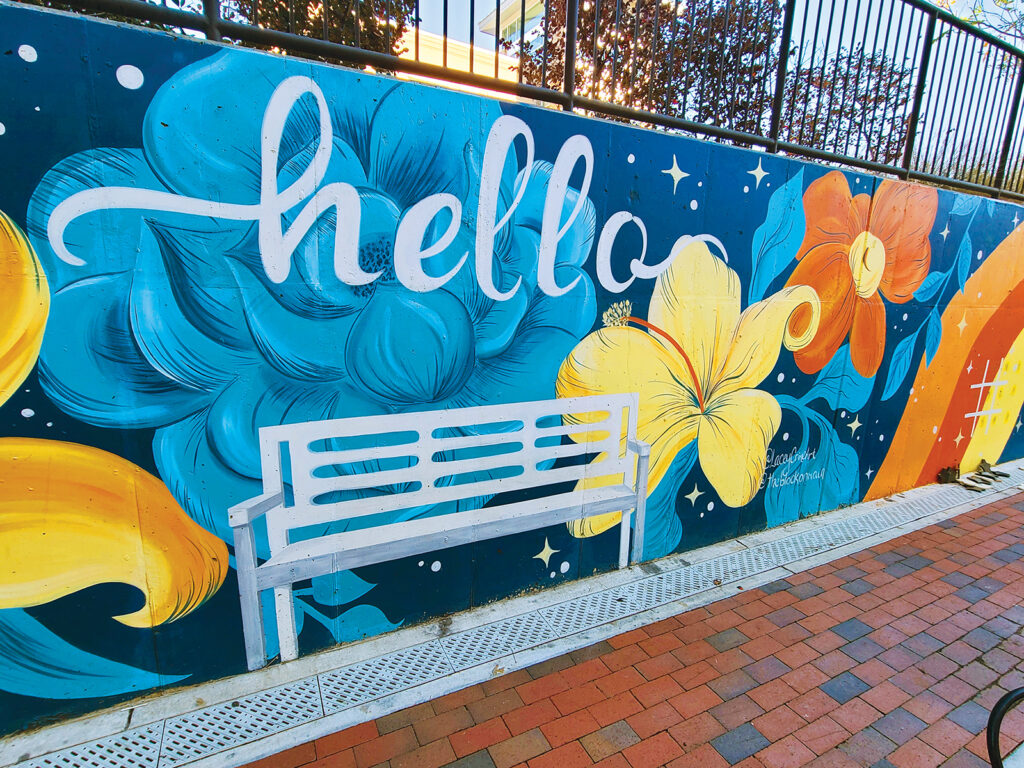
Mural at The Block on Main
Painted by Lacey Crime in 2021.
Located at The Block on Main, 300 S. Main Street.
The Block on Main is an anchor of downtown Holly Springs, housing many popular dining and social venues. Chris Harol, a local business owner at The Block on Main, launched the nonprofit Downtown Alive to energize Holly Springs’ Village District with activities and art that celebrate community spirit and small business. The organization, led by a team of local business and community leaders, aims to make Holly Springs a vibrant destination by hosting regular events like spring art festivals, holiday celebrations and monthly pop-ups.
Harol saw a mural at The Block on Main as a natural fit for this vision—a way to enhance the area’s visual appeal and a source of pride for residents. Through an open call for art, Downtown Alive selected local muralist Lacey Crime to design an interactive, colorful mural as the district’s focal piece. They hoped it would help draw people downtown, support local vendors and build a sense of place and identity for Holly Springs.
Completed in February 2021, the mural features floral elements and the word “hello” in elegant script. It integrates a bench into the work, allowing passersby to become part of the scene, and making the mural a popular spot for selfies. Crime’s initial design was quickly embraced by locals, prompting her to return for a second phase: an expansion that added a chalkboard wall, tic-tac-toe grids and additional details that extend the interactive experience.
“I wanted it to be interactive, a piece for everyone—inviting people to stop, smile and engage,” Crime says. “The colors, the games, even the added extensions—all reflect a desire to bring something fun for the public to enjoy in Holly Springs.”
Crime blends digital planning with traditional painting techniques to create her vibrant murals. When moving to a larger scale, such as that of The Block on Main mural, she adapts her technique, mixing freehand painting with scaling to ensure the design fits perfectly into its space. This flexibility allows her to transform her digital concepts into engaging, interactive public art.
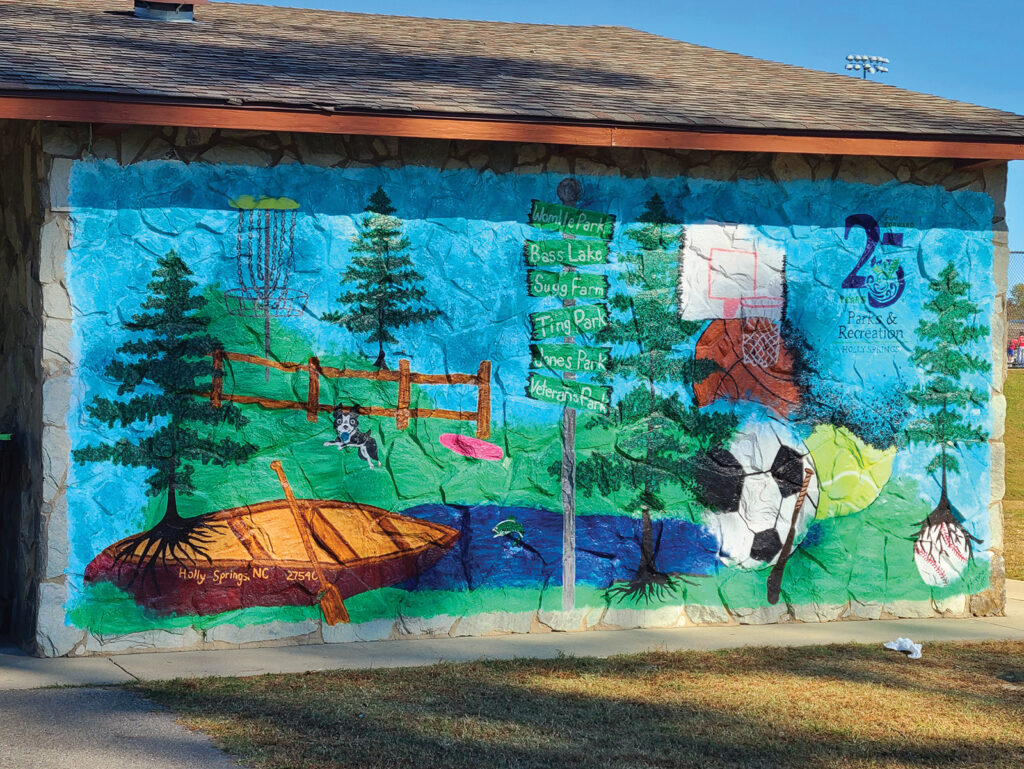
Rooted in Nature
Painted by Regina Carter in 2021.
Located at Womble Park, 1201 Grigsby Avenue.
Womble Park’s mural, commissioned in honor of the Parks & Recreation Department’s 25th anniversary, was created by local artist Regina Carter. The mural captures the essence of Holly Springs, incorporating elements of nature that reflect the beauty and tranquility of the park itself. Carter’s work brings vibrant color and energy to the surroundings, enhancing the visitor experience while serving as a visual reflection of the town’s commitment to community art.
Looking Forward: A Future for Public Art in Holly Springs
With the formation of the Holly Springs Arts Council and potential collaborations with the Wake Murals program, the town is eager to expand its public art offerings. These partnerships aim to bring more public art to Holly Springs— including murals—creating opportunities for local artists and residents to contribute to the town’s visual landscape. Plans for additional murals and art projects in the coming years reflect a commitment to fostering a vibrant, creative environment that attracts both locals and visitors.
Public art here isn’t just decoration—it’s a way to bring people together, celebrate shared spaces and tell a town’s unique story.
PAINTING THE TOWN: MORRISVILLE
BY ELIZABETH LINCICOME | PHOTOS BY THE TOWN OF MORRISVILLE
Morrisville is now home to three new murals that, while very different in subject matter, all pay homage to the town’s rich history, natural beauty and cultural heritage. All funded by the Town of Morrisville, these murals are just one component of the town’s developing public art initiative.
Upon receiving an Arts for Towns grant from United Arts Wake County in the fall of 2023, the town issued a call for artists. The artists who were selected are required to maintain the murals for at least two years after installation. “It’s our hope that these murals will be in place for many years to come,” says Brittany Johnson, planning manager for the Town of Morrisville.
The murals all celebrate the diversity of Morrisville’s population and the cohesion amongst the community.
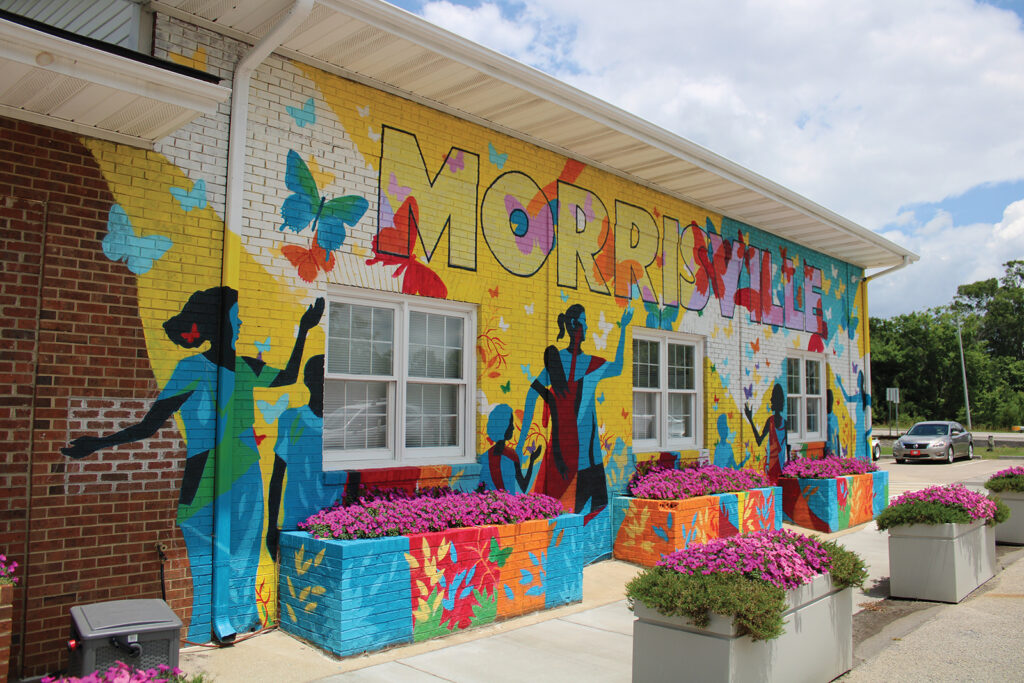
Dancing on the Breeze
Painted by Max Dowdle in 2024.
Located at 100 Morrisville Carpenter Road, Morrisville’s fire administration building.
“This mural represents all ages living in harmony, and reflects our sense of community,” says local artist Max Dowdle. “I was tapped to conceive of a design that was vibrant, energetic and, most importantly, welcoming.”
Since the building is located on a main road into town, during the planning process, Dowdle stressed the importance that it be eye-catching and prominently feature the name of the town. “I submitted a number of designs, but the butterfly one was favorably settled on, and with a few additional tweaks we got it to a very pleasing point,” he says.
Dowdle’s other work is heavily featured throughout the state, as well as in Washington, D.C. and New Jersey. (We profile another of his murals in Western Wake on page 55.) He is currently engaged in a statewide project entitled Legacy NC: 100 Murals in 100 Counties, which commemorates historic and modern legends, luminaries and unsung heroes. He began his public artwork in 2019 after a long career in fine art. “I find it tremendously rewarding and gratifying to work with municipalities to help bring their creative visions to life,” says Dowdle.

Roots and Wings
Painted by Sampada Agarwal in 2024.
Located at 1301 Morrisville Parkway, the Morrisville Aquatics & Fitness Center (MAFC).
Sampada Agarwal is a visual artist who has been practicing the folk and tribal art styles of India for over 20 years. Her Roots and Wings mural portrays a sprawling tree offering a haven for many colorful birds. Each bird is unique and special, yet together they create a rainbow of colors that live in harmony.
“Each bird is detailed with intricate and different patterns, in tune with the hallmark style of Gond art,” Agarwal says, referring to a style from the state of Madhya Pradesh in India.“This playful, colorful style is steeped in tradition, yet contemporary in nature.”
“The varied patterns symbolize the diversity in our community,” says Agarwal. A red triangle at the base stands for Research Triangle Park, and the airplane alludes to Raleigh-Durham International Airport and Morrisville’s global connectivity. The fish is a reference to the aquatic element of the MAFC building.
